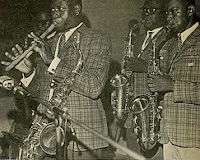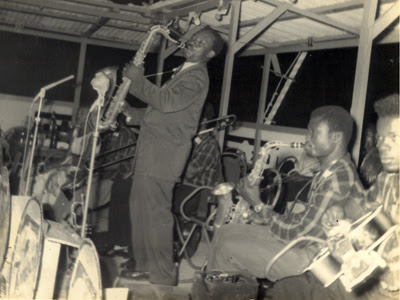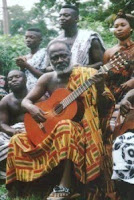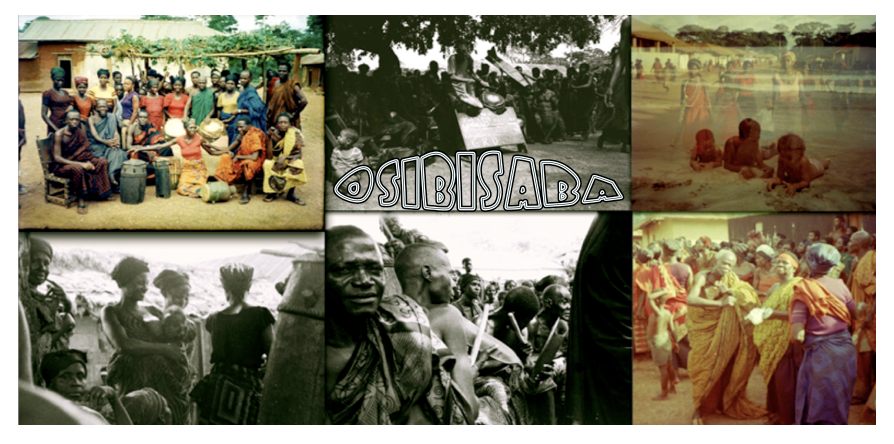On the heels of the previous post, here's the other Original Music compilation featuring Ghanaian "Dance band" music, Telephone Lobi (1995). This album offers some more variety, as a greater selection of bands have been chosen by the OM folks. This broader representation of the Ghanaian "dance band" scene in turn reflects a greater diversity of individual styles and sounds. Be sure to check out these great tunes, including some of my favorites like the Ramblers' "Agbo Ayee" and "Me Ye Fun" by the Police Band #1.
Mbra Nimfo Quist - Builders Brigade
Wednesday, September 29, 2010
Tuesday, September 28, 2010
Giants of Danceband Highlife, 1950s-1970s
 Giants of Danceband Highlife (1990) is another great, hard-to-find Original Music compilation. This one features tracks by three of the most famous and prolific Ghanaian dance bands, E.T. Mensah's Tempos, the Ramblers, and Uhuru.
Giants of Danceband Highlife (1990) is another great, hard-to-find Original Music compilation. This one features tracks by three of the most famous and prolific Ghanaian dance bands, E.T. Mensah's Tempos, the Ramblers, and Uhuru.Download it Here.
"The big dance bands flourished during the 1950s and 1960s in both Ghana and Nigeria. In Ghana, the leading bands played regularly in the major towns, now growing rapidly in population ... The large towns like Accra, Cape Coast, and Kumasi had prestigious ballroom orchestras which played waltzes, foxtrots, quicksteps, ragtimes, rumbas, and highlifes to a black elite audience in top hats and evening dress. The earliest of these was the Excelsior Orchestra formed in 1914. It was in this context of local melodies like the Osibisaba and Ashiko, being orchestrated for an upper class audience, that the term "highlife" was coined (Collins, Musicmakers of W. Africa).
Comprising a typical line-up of brass, vocals, percussion, drums, double bass and electric guitar, the bands could play a bewildering variety of styles reflecting popular demand although highlife itself remained the staple affair. The lyrics were also delivered in a variety of languages including Twi, Fante, Ga, Efik, Ibo, Ewe, and Hausa (as well as English and Spanish).
During the 1960s, many dance bands suffered at the hands of the state bands who, by offering a regular salary and stable employment, attracted many of the best musicians away from the private highlife bands. Many of the large state corporations, from the Cocoa Board and the Black Star line to the state hotels and the Builders Brigade, formed their own outfits. By the 1970s, hard on the heels of economic decline and an increase in the demand for imported music, highlife dance bands were steadily declining in number and popularity. The Tempos and the Uhurus staggered on but it was really only the Ramblers who survived as a viable musical unit (R. Graham, The Da Capo Guide)."
Note: Graham's description of Dance band stagnation seems somewhat inaccurate to me, as he fails to mention contrary trends such as the continuous popularity of King Bruce's dance bands, Uhuru's later successes (e.g. excursions into Afrobeat and fusion music with Oscar Sulley), and E.T. Mensah's '70s revival.
 |
| E.T. Mensah |
 |
| Ramblers Dance Band |
 |
| Stan Plange & Uhuru |
 |
| Jerry Hansen of Ramblers |
Labels:
Dance band,
E.T. Mensah,
Highlife,
Original Music
Thursday, September 23, 2010
Sweet Talks - Spiritual Ghana
Sweet gospel music with "Spiritual Ghana (1976)" from the ever-popular Sweet Talks. The brainchild of singer A.B. Crentsil and leader/guitarist Smart Nkansah (who would later split to form the fantastic Sunsum Band), the Sweet Talks were always at the top of their game in the '70s.
On side one we have a medley of Ghanaian hymns and church songs, while side two is described as "Osode" music. This traditional Fanti genre was made famous by C.K. Mann, who brought a highlife twist to this "modern Osode."
 |
| Get out your white handkerchiefs for this one! Download |
Labels:
A.B. Crentsil,
Gospel,
Highlife,
Smart Nkansah
Saturday, September 18, 2010
Palmwine Videos: T.O. Jazz & Koo Nimo
If you've enjoyed the recent posts here about palmwine music then I'm sure you'll also appreciate these two fantastic videos, courtesy of youtube (if you haven't seen them already). The first features the late T.O. Jazz playing a heartbreakingly beautiful solo piece, it looks like near the music department at the University of Ghana, Legon. Is anyone familiar with this highlife song? I'd love to known the title and composer. T.O. Jazz is absolutely one of the great old-time highlife musicians in my book, so stay tuned for more music from him in the future.
For the second video we have Koo Nimo performing at a music festival in the Netherlands, again joined onstage by Osei Korankye (this time Osei is singing whilst alternating between premprensua and hand drums).
Enjoy watching these inspiring highlife legends!
Enjoy watching these inspiring highlife legends!
Thursday, September 16, 2010
I've Found My Love: 1960's Guitar Band Highlife of Ghana
John Storm Roberts' Original Music label released some fantastic, groundbreaking compilations of old African music from across the continent during the 1990s, so it's a shame that these CDs are now out of print and so difficult to find. I've Found My Love is, to me, one of the particularly special Original Music releases. Each one of these electric, guitar-band highlife tunes is more excellent than the last! Old-time greats like King Onyina and S.K. Oppong appear, along with other familiar names like Akompi, Akwaboa, and the Royal Brothers. If you enjoy this music check out Akom Ko (another similar compilation) over at Likembe, this one also featuring a few dance-band style tunes.
Download I've Found My Love Here
The liner notes included with I've Found My Love don't seem particularly well written in my opinion in terms of content and scope, but they're worth checking out for some general historical background on highlife if you'd like:
Labels:
Atumpan,
Guitar Band,
Highlife,
King Onyina,
Original Music
Sunday, September 12, 2010
Koo Nimo & Osei Korankye - Tete Wobi Ka
Here's another album of palmwine music by one of my favorite musicians, Koo Nimo. The record is Tete Wobi Ka (2000), and here Agya Koo is joined by Osei Korankye, another truly one-of-a-kind musician. Osei plays the Akan harp seprewa, the original instrument of Ghanaian palm-wine music (pictured last below). This is a particularly important instrument, as it is the style and playing technique of seprewa, translated onto the guitar, that has remained at the core of Ghanaian highlife from the 1920s through the 21st century. Osei is also a singer, and his tenor provides backing to Koo Nimo's deeper, resonant voice through much of this album (I'll be devoting another post to Osei in the coming weeks).
Tete Wobi Ka doesn't appear to be commercially available any longer, so I've offered it here for download . Koo Nimo's excellent first album Osabarima is (I believe) still available commercially for purchase.
Below is a bit of biography on Koo Nimo himself:
"World-renowned Palm Wine musician, guitarist Daniel Amponsah, best known by his stage name Koo Nimo is often referred to as the “National Treasure” of Ghana. Thought of as a “living legend” by many Ghanaians, Koo Nimo's music has been a very relevant source of musical inspiration and continues to be after 40 years of performance.
Apart from his early exposure to music by his parents and playing in local groups, particularly I.E.'s Band, Koo Nimo also studied classical guitar style, harmony, counterpoint etc. at various times, to enhance his musical appreciation. "I didn't want to be a Segovia. I wanted to be an African guitarist, using my technique to do justice to my own music which I understand better," explains Agya Koo, as he is generally known in Ghana.
Although a great consumer of jazz music- from Charlie Parker, Duke Ellington, John Coltrane, Wes Montgomery, Count Basie through Antonio Carlos Jobim and Lorendo Almeida to Thelonius Monk- Agya Koo drew inspiration first from Ghanaian guitarist Kwabena Onyina. But as he explains, "I didn't, however, want to be a second-rate guitarist, hence my determination to dig into my past for a traditional sound which I have now fashioned." He has represented his country with his Adadam Agofama Group at several international arts festivals and has also toured extensively throughout Europe and America, where he shared the stage with Puerto Rico's Yomo Toro during a 1988 "Guitar Summit".
Notwithstanding his stature and popularity, both within and outside Ghana, Agya Koo remains a man of the people committed to re-exposing his countrymen, particularly the young, to their own folk music. His priceless music represents a living art form - not a museum showpiece."
- http://homepage.ntlworld.com/latham/koonimo/afrofest.htm
 |
| Osei & Agya Koo |
Labels:
Akan,
Highlife,
Koo Nimo,
Osei Korankye,
Palmwine Music,
Seprewa
Thursday, September 9, 2010
Palmwine Music: Ayonko Asiwa Group - Koobi Awaree
You can download it here .
If you're interested, here's a brief bit of historical background on Ghanaian palmwine music from scholar John Collins:
In Ghana it was the Kru-taught musician Kwame Asare (Jacob Sam) whose Kumasi Trio made the first recordings of "palm wine music" in 1928 when they went to London to record for Zonophone. This session also included the first recording of the famous song "Yaa Amponsah" which provided one of the most enduring and important melodo-rhythmic riffs found in Ghanaian highlife.
 |
| Premprensua |
Koo Nimo, one of the truly great living palmwine musicians, gives his own perspective on the origins of this genre:
 "Palmwine is a local drink. In villages you find, under a shady tree, in the afternoons old men would relax and be telling stories about life. Marriage experiences, disappointments. Now, at that time seprewa was the instrument, the African harp-lute. And the seprewa player might be sitting around, then a palmwine tapper would bring a pot of palmwine, usually identified by the foam on top. Then the calabash is passed round and they drink of palmwine. Now the music that is played under that environment was called palmwine guitar music. In this way, acoustic and folklore Highlife music inherited its name from the fact that it gained its popularity at Palm Wine bars, which symbolically represented music of the masses."
"Palmwine is a local drink. In villages you find, under a shady tree, in the afternoons old men would relax and be telling stories about life. Marriage experiences, disappointments. Now, at that time seprewa was the instrument, the African harp-lute. And the seprewa player might be sitting around, then a palmwine tapper would bring a pot of palmwine, usually identified by the foam on top. Then the calabash is passed round and they drink of palmwine. Now the music that is played under that environment was called palmwine guitar music. In this way, acoustic and folklore Highlife music inherited its name from the fact that it gained its popularity at Palm Wine bars, which symbolically represented music of the masses."If you're further interested in this music be sure to check out the "Vintage Palmwine" album (recorded and released by John Collins) featuring classic palmwine musicians T.O. Jazz, Kwaa Mensah, and Koo Nimo.
Also, this album by Kwabena Nyama will simply blow you away!
Subscribe to:
Posts (Atom)











